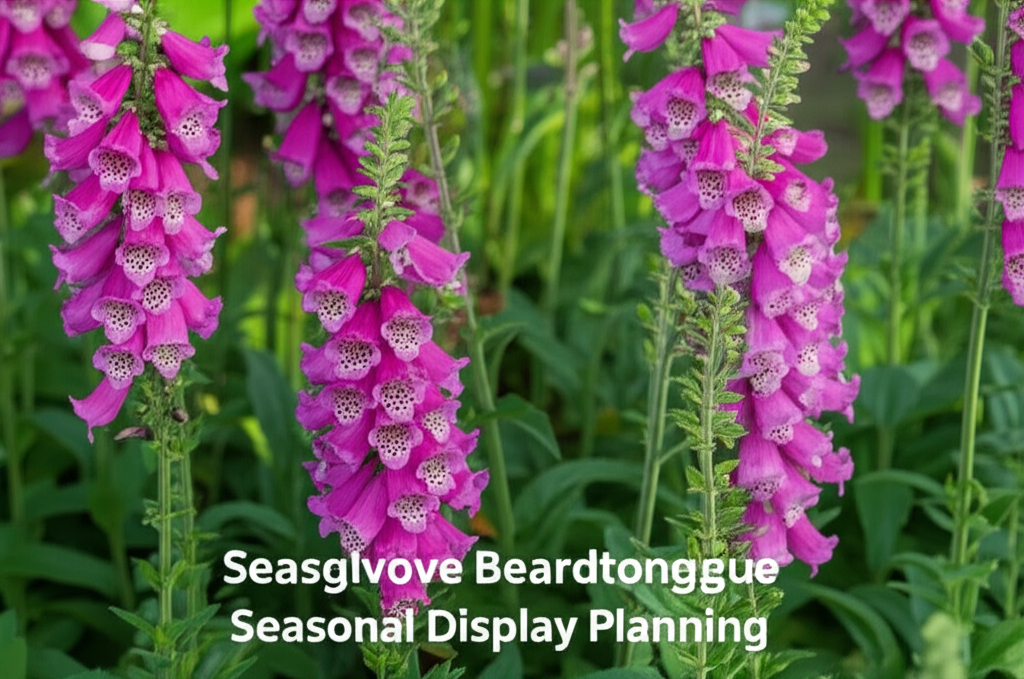Introduction to Foxglove Beardtongue (Penstemon digitalis)
Foxglove Beardtongue, scientifically known as Penstemon digitalis, is a captivating native perennial that offers a spectacular and prolonged floral display, making it a valuable addition to any garden seeking vibrant color and ecological benefit. While its common name might suggest a resemblance to the highly toxic Foxglove (Digitalis purpurea), it’s crucial to understand that Foxglove Beardtongue belongs to a different genus and is non-toxic. Its tall, stately spikes of tubular, often white or pale lavender flowers, emerging in late spring and continuing through summer, attract a host of pollinators, including bees, butterflies, and hummingbirds. This guide will delve into the intricacies of planning a successful seasonal flower display with Foxglove Beardtongue, covering everything from site selection and soil preparation to companion planting and long-term care.
Understanding the Needs of Foxglove Beardtongue

To cultivate a thriving Foxglove Beardtongue display, understanding its preferred growing conditions is paramount. This hardy perennial is known for its adaptability, but providing it with the right environment will ensure a more robust and visually stunning bloom.
Sunlight Requirements
Foxglove Beardtongue thrives in full sun to partial shade.
- Full Sun (6+ hours of direct sunlight per day): This is the ideal condition for the most prolific blooming. In hotter climates, some afternoon shade can be beneficial to prevent wilting.
- Partial Shade (3-6 hours of direct sunlight per day): The plant will still grow and flower, but the bloom count and intensity may be slightly reduced.
- Deep Shade: Avoid planting in areas that receive less than 3 hours of direct sunlight, as this will lead to leggy growth and minimal flowering.
Soil Preferences
The key to successful Foxglove Beardtongue cultivation lies in well-draining soil. It is surprisingly tolerant of a range of soil types, from sandy to loamy, but consistently wet or waterlogged conditions can lead to root rot.
- Ideal Soil: Loamy soil with good drainage, rich in organic matter.
- Tolerant Soils: Sandy soils (may require amendment with compost to retain moisture), clay soils (require amendment to improve drainage, e.g., by incorporating grit or compost).
- Avoid: Heavy, compacted soils that hold excess moisture.
Moisture Needs
Once established, Foxglove Beardtongue is remarkably drought-tolerant. However, consistent moisture is important during the initial establishment phase.
- Newly Planted: Water regularly to keep the soil consistently moist but not soggy.
- Established Plants: Water during prolonged dry spells, but generally, rainfall will suffice. Overwatering is a common mistake and can be detrimental.
Hardiness Zones
Foxglove Beardtongue is a resilient plant, typically hardy in USDA Zones 3-9. This wide range makes it suitable for a vast array of climates across North America.
Key Facts and Comparison
To better understand Foxglove Beardtongue’s place in the garden, let’s compare it with other popular flowering perennials.
| Feature | Foxglove Beardtongue (Penstemon digitalis) | Salvia (Salvia spp.) | Echinacea (Echinacea spp.) | Daylily (Hemerocallis spp.) |
|---|---|---|---|---|
| Bloom Time | Late Spring to Summer | Varies widely by species (Spring to Fall) | Summer to Early Fall | Late Spring to Summer (many reblooming varieties) |
| Flower Shape | Tubular, open-mouthed | Tubular, often two-lipped | Daisy-like, ray florets and prominent cone | Trumpet-shaped, six tepals |
| Height | 2-4 feet | 1-5 feet (varies by species) | 2-5 feet | 1-5 feet |
| Sun Exposure | Full Sun to Partial Shade | Full Sun (most species) | Full Sun to Partial Shade | Full Sun to Partial Shade |
| Drought Tolerance | High (once established) | Moderate to High (depends on species) | High | Moderate |
| Pollinator Attraction | Excellent (bees, butterflies, hummingbirds) | Excellent (bees, butterflies, hummingbirds) | Excellent (bees, butterflies) | Good (bees, butterflies, hummingbirds) |
| Native Status | Native to North America | Varies (many are native to North America) | Native to North America | Native to Eurasia, naturalized in North America |
Designing Your Foxglove Beardtongue Display: Site Selection and Preparation
The foundation of any successful garden display is thoughtful site selection and meticulous preparation. This ensures your Foxglove Beardtongue plants have the best possible start and continue to flourish year after year.
Choosing the Right Location
Consider the mature size of the plant and its sunlight requirements.
- Front of Borders: While attractive, their 2-4 foot height might overshadow smaller plants. Consider planting them towards the middle or back of borders.
- Meadow Gardens: Foxglove Beardtongue is a superb choice for naturalistic settings and meadow designs, where its height and airy form can blend seamlessly.
- Pollinator Gardens: Its strong appeal to beneficial insects makes it a cornerstone of any pollinator-focused planting.
- Rain Gardens: While it prefers good drainage, it can tolerate some moisture and is often found in mesic (moderately moist) prairie environments.
Soil Preparation Techniques
Good soil structure is key to preventing root rot and promoting healthy growth.
- Amending Clay Soil: Incorporate generous amounts of compost, aged manure, or coarse sand to improve drainage and aeration. Double digging can also help break up compacted layers.
- Amending Sandy Soil: Add compost or other organic matter to improve water and nutrient retention.
- Testing Soil pH: Foxglove Beardtongue generally prefers slightly acidic to neutral soil (pH 6.0-7.5). Most garden soils fall within this range, but a soil test can confirm and guide any necessary amendments.
Planting Strategies
The spacing and arrangement of your Foxglove Beardtongue plants will significantly impact the overall aesthetic and health of the display.
- Spacing: Plant them 18-24 inches apart to allow for adequate air circulation and full growth. Overcrowding can lead to disease and reduced flowering.
- Mass Planting: For a dramatic effect, plant in drifts or clusters of 3-7 plants. This creates a more impactful visual statement.
- Companion Planting: Consider pairing Foxglove Beardtongue with plants that have complementary bloom times, textures, and colors.
Seasonal Interest and Companion Planting
A well-planned garden provides continuous beauty throughout the growing season. Foxglove Beardtongue’s bloom time makes it a valuable player in achieving this.
Spring: The Anticipation
While Foxglove Beardtongue’s main show is in summer, its foliage emerges early in spring, providing ground cover and structure.
- Early Spring Companions: Pair with spring ephemerals like Virginia Bluebells (Mertensia virginica), or bulbs like Camassia. Their delicate blooms will fade before Foxglove Beardtongue reaches its full height.
Summer: The Main Event
This is when Foxglove Beardtongue truly shines, with its elegant spires of flowers.
- Complementary Color Palettes:
Blues and Purples: Combine with Salvias, Veronica, Baptisia (False Indigo), or Lavender.
Yellows and Oranges: Pair with Coneflowers (Echinacea), Black-Eyed Susans (Rudbeckia), or Coreopsis.
Whites and Silvers: Mix with Astilbe, Shasta Daisies (Leucanthemum x superbum), or Yarrow (Achillea).
- Texture and Form:
Grasses: Interplant with ornamental grasses like Little Bluestem (Schizachyrium scoparium) or Switchgrass (Panicum virgatum) for textural contrast and movement.
Fine-Textured Foliage: Combine with ferns or Liatris (Blazing Star) for a more ethereal look.
Bold Foliage: Contrast with plants like Hostas (in partial shade) or Daylilies for a more robust feel.
Fall: The Transition
Even after flowering, Foxglove Beardtongue offers winter interest. The dried seed heads provide structure and food for birds, while its sturdy stems can withstand winter winds.
- Fall Companions: Asters, Goldenrod (Solidago), and ornamental grasses continue to provide color and texture well into autumn.
Care and Maintenance for Long-Term Success
Proper care ensures your Foxglove Beardtongue not only blooms profusely but also remains healthy and vigorous for many years.
Watering Practices
As mentioned, Foxglove Beardtongue is drought-tolerant once established.
- First Year: Provide consistent moisture, watering deeply when the top inch of soil feels dry.
- Established Plants: Water only during extended dry periods. Overwatering is more likely to cause problems than underwatering.
Fertilizing Needs
Foxglove Beardtongue generally does not require heavy fertilization.
- Annual Mulching: A yearly top-dressing of compost in early spring is usually sufficient to provide necessary nutrients and improve soil structure.
- Avoid High-Nitrogen Fertilizers: These can promote excessive leafy growth at the expense of flowers.
Pruning and Deadheading
The approach to pruning depends on your aesthetic goals.
- Deadheading: While not strictly necessary, removing spent flower stalks can encourage a second flush of blooms, though usually smaller. It also maintains a tidier appearance.
- Cutting Back: You can cut the plants back after the first frost or leave the seed heads for winter interest and to provide food for birds. If cutting back, do so in late winter or early spring before new growth begins.
- Division: Foxglove Beardtongue does not typically require frequent division. If plants become overcrowded or flowering diminishes, they can be divided in early spring or fall.
Pest and Disease Management
Foxglove Beardtongue is generally quite resistant to pests and diseases.
- Common Issues: Occasionally, it might be susceptible to powdery mildew in humid conditions or if planted too closely. Ensuring good air circulation through proper spacing is the best preventative measure.
- Pests: Slugs and snails can sometimes be an issue, especially for young plants. Hand-picking or using organic slug baits can help.
Propagation Methods
There are several ways to increase your Foxglove Beardtongue collection or share it with fellow gardeners.
Seed Propagation
Growing from seed is a cost-effective method, though it may take a year or two for plants to reach flowering size.
- Timing: Sow seeds in late winter or early spring indoors, or directly outdoors after the last frost.
- Germination: Seeds require light to germinate, so sow them on the surface of the soil. Keep them consistently moist and cool.
Division
This is the most common and easiest method for propagating established plants.
- Timing: Best done in early spring as new growth emerges, or in the fall after the flowering season has ended.
- Process: Carefully dig up the plant, divide the root ball into sections using a spade or sharp knife, ensuring each division has healthy roots and at least one growth bud. Replant immediately.
Cuttings
While less common, stem cuttings can also be taken.
- Timing: Softwood cuttings can be taken in late spring or early summer.
- Process: Take cuttings from new growth, remove lower leaves, and dip in rooting hormone. Plant in a moist, well-draining potting mix.
Pros and Cons of Foxglove Beardtongue
Like any plant, Foxglove Beardtongue has its advantages and disadvantages to consider in your garden planning.
| Pros | Cons |
|---|---|
| Spectacular floral display: Tall, elegant spikes of attractive flowers. | Can be a bit leggy: May require staking in windy areas or if heavily mulched. |
| Excellent for pollinators: Highly attractive to bees, butterflies, and hummingbirds. | Not suitable for deep shade: Requires at least partial sun for good flowering. |
| Drought-tolerant once established: Low maintenance in drier periods. | Requires well-draining soil: Susceptible to root rot in waterlogged conditions. |
| Hardy and adaptable: Tolerant of a wide range of soil types and climates (Zones 3-9). | Foliage can emerge early: May be damaged by late frosts in colder climates, but usually recovers. |
| Provides winter interest: Dried seed heads offer structure and food for wildlife. | May be confused with toxic Foxglove: Clear labeling and education are important if children or pets are present. |
| Native plant: Supports local ecosystems and biodiversity. | Can self-seed: While generally not aggressive, in ideal conditions, it might spread to adjacent areas. |
Conclusion: Embracing the Beauty of Foxglove Beardtongue
Foxglove Beardtongue (Penstemon digitalis) is a truly rewarding perennial for gardeners seeking a long-lasting, vibrant, and ecologically beneficial floral display. Its adaptability, drought tolerance, and stunning blooms make it a cornerstone for pollinator gardens, meadow landscapes, and mixed borders. By carefully considering its sun, soil, and moisture requirements, and by thoughtfully integrating it with complementary plants, you can create a dynamic and beautiful garden that evolves beautifully throughout the seasons. Embrace the stately elegance of this native gem and enjoy the buzzing activity of pollinators it so generously attracts.


